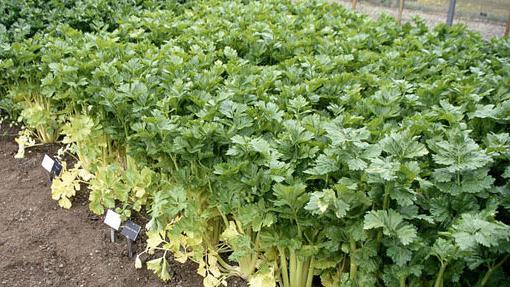
In the CIS countries, celery is popularroot, but its no less useful fellow is increasingly found on the shelves of our shops and on the sites of truck farmers. Growing celery celery is a bit troublesome, but fascinating.
This plant grows wild in Europe,Asia, South and North Africa, South America. Growing celery is produced for juicy, thick and crunchy stems (petioles). They are eaten raw, used for salads, soups and stews.


With a complex way of growing a plant,In the trenches, at the same time they are constantly hilled or wrapped in black film. These actions are aimed at bleaching the stems. Their hilling and wrapping stimulates the formation of longer, more elastic, less fibrous and without bitterness petioles. For this method, the following grades are suitable: white - white feather, dwarf white, white liner; pink - jainte pink, cleavots price pink; red - standard berer, jain ed.
Growing celeryto carry out in open areas of fertile soil. For self-bleaching varieties in the soil before planting for the winter, add the dumped manure (bucket / sq.m.). For trench types, a pit 30 cm deep and 50 cm wide is prepared from autumn. The soil dug from it is poured on the sides of the pit. On the loosened pitchfork, the bottom of the trench is filled with the rotted manure (bucket / sq.m.). Manure is sprinkled with earth.
Seeding of seeds of self-bleaching varieties producesthus: they are mixed with sand and sown in trays with a substrate. The air temperature should be 10-14 ° C. The crops are sprinkled with a substrate and thoroughly watered. You can cover the tray with a plastic film. Adult seedlings are dived and planted at an interval of 5 cm in trays with a substrate. Celery seedlings are grown in a greenhouse or a greenhouse. Plant seasoned seedlings in the middle of May according to the scheme of 25x25 cm.

Seedlings for trenchinggrow on the same principle. It is planted in the middle of the trench. Plants are watered abundantly. After the stems have reached 30 cm in length, the celery begins to hull or wrap each plant with a plastic wrap. At the same time weak lateral shoots are cut off. They hibernate every 2 weeks.
This plant is damaged by carrot andCelery fly, snails and slugs. Celery celery is susceptible to rifling, cracking and leaf spotting. To prevent diseases and the appearance of pests, it should be regularly treated with special preparations.
</ p>>